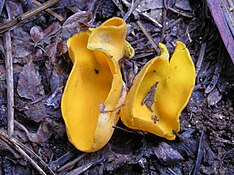Caloscypha
| Caloscypha | |
|---|---|
 |
|
| Scientific classification | |
| Kingdom: | Fungi |
| Division: | Ascomycota |
| Class: | Pezizomycetes |
| Order: | Pezizales |
| Family: | Caloscyphaceae |
| Genus: | Caloscypha |
| Species: | C. fulgens |
| Binomial name | |
|
Caloscypha fulgens (Pers.) Boud. (1885) |
|
| Synonyms | |
| Caloscypha fulgens | |
|---|---|
| Mycological characteristics | |
| glebal hymenium | |
| no distinct cap | |
| hymenium attachment is not applicable | |
| lacks a stipe | |
| spore print is white | |
| ecology is saprotrophic | |
| edibility: inedible | |
Caloscypha is a fungal genus in the family Caloscyphaceae (order Pezizales). A monotypic genus, it contains the single species Caloscypha fulgens, commonly known as the spring orange peel fungus, the golden cup, or the dazzling cup. It is a cup fungus, typically up to 4 centimetres (1.6 in) in diameter, with a bright to pale orange interior and orange; specimens that are old or bruised often have an olive-green discoloration, especially around the edges. In North America, it is usually found on the ground in forest litter near conifers. Fruiting occurs in early spring following snow melt. The asexual (imperfect), or conidial stage of C. fulgens is the plant pathogenic species Geniculodendron pyriforme, known to infect dormant seeds of the Sitka spruce.
This species was first described by Christian Hendrik Persoon in 1822 as Peziza fulgens, and has been grouped in several different genera since its original description. Phylogenetic analysis of DNA sequence data shows that within the Pezizales order, Caloscypha fulgens belongs in an evolutionary lineage with the families Helvellaceae, Morchellaceae, and Tuberaceae. Since 1968, Caloscypha had been placed in the Pyronemataceae family, a small grouping of fungi distinguished from other Pezizales by their relatively undeveloped peridium. In 2002, the new family Caloscyphaceae was described to contain the monotypic genus Caloscypha.
...
Wikipedia
